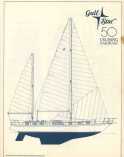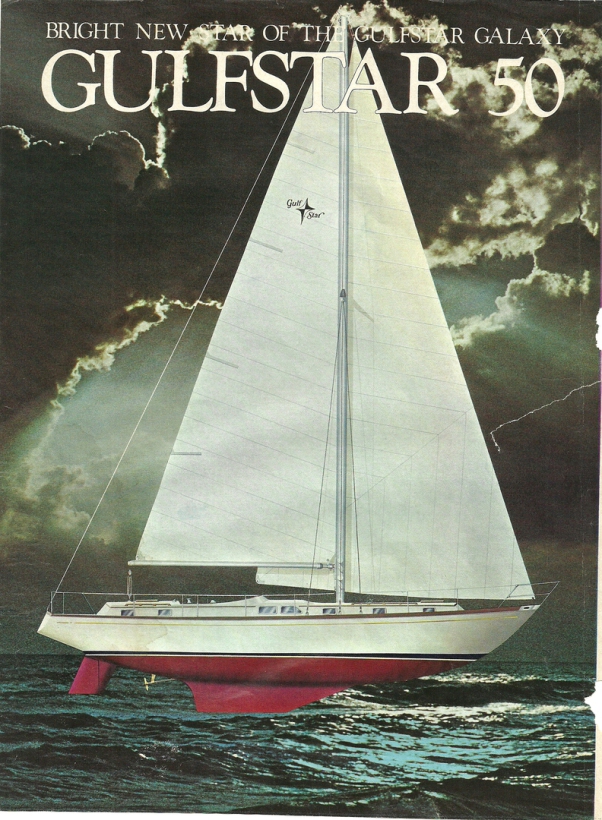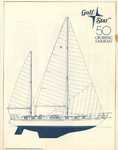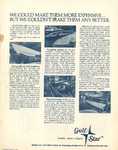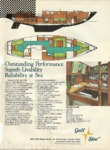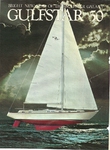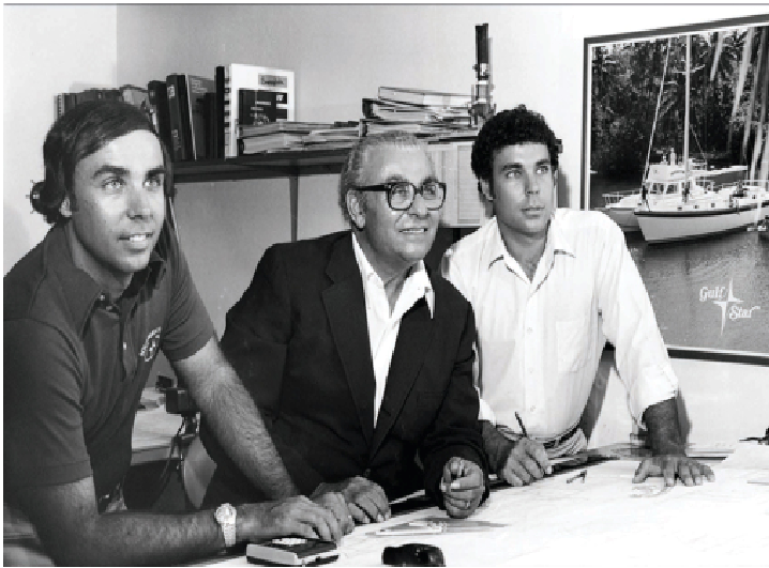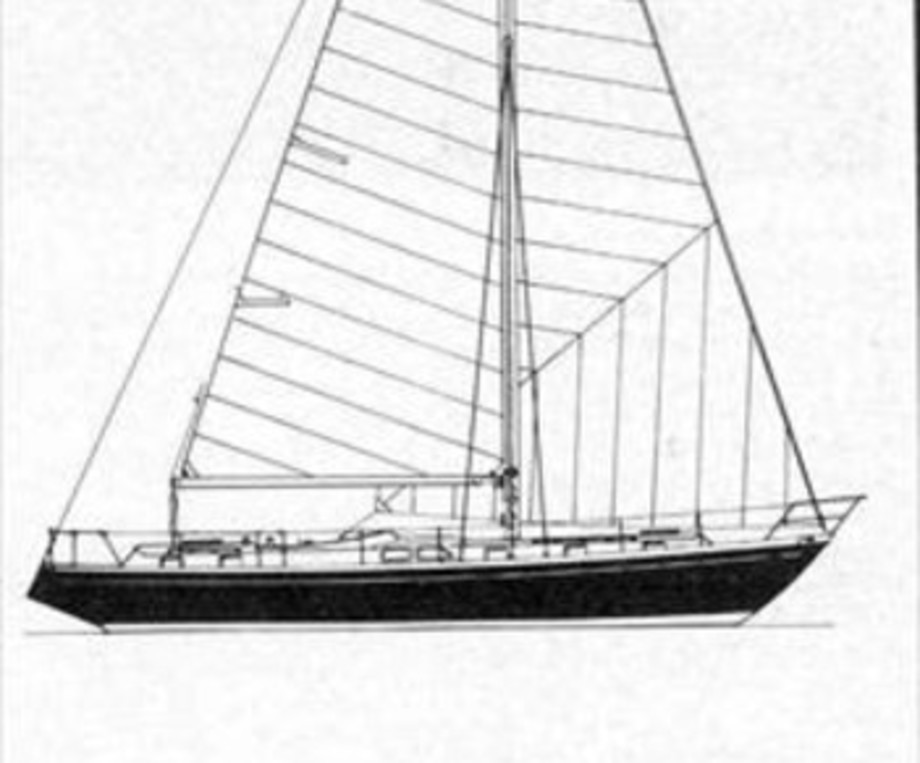
172 Gulfstar 50 sailboats produced from 1975 to 1980
May 4, 2010
Gulfstar Yachts Review: A Complicated History
Filed under: Reviews — Tags: Caribbean Sailing Yachts (CSY), Columbia Yachts, Gulfstar Yachts, Vincent Lazzara — Richard Jordan @ 1:32 pm
Gulfstar Early Model Star Logo
Gulfstar Yachts was founded in 1970 by Vincent Lazzara in Tampa Bay, Florida. Mr. Lazzara was fresh off a two year forced absence from the power and sailboat building business. As part of selling his share in Columbia Yachts, he signed a non-compete clause and boded his time building houseboats. In 1970, Mr. Lazzara was already a legendary figure who had invented a snap-shackle variation, helped build one of the first fiberglass sailboats in the Rhodes designed Bounty II, and was involved with Columbia Yachts which was one of the leading early builders of fiberglass sailboats. But, his greatest legacy was to be Gulfstar Yachts.
The Gulfstar Story
Mr. Lazzara drawing on his experience decided to produce sailboat hulls that could double as trawlers. With a different deck mold and larger engine, Gulfstar delivered 53 and 36-foot trawlers while by stepping a mast, they had 53 and 36 motorsailers. He tapped into the floating condominium mentality of the public and built exactly what would sell. The sailboats had great accommodation but poor performance with their shoal draft, short rigs, and wide beam. Other boats produced during this era include a 43 trawler and 44 motorsailer.
While Mr. Lazzara was experienced in boat building, his crew at the Tampa Bay factory were not. In the early Gulfstar years, the workmanship bordered on criminal. Some choices were made to save money and produce boats inexpensively. The interiors were full of Formica. The ballast was iron in concrete slurry. But other problems had less to do with philosophy and more to do with poor practices. The balsa cored decks did not have solid radii of glass around deck hardware and were not sealed with resin either. They did not use backing plates for cleats. Workmen according to a former yard hand would carelessly cut holes in the deck and leave unfinished hulls out in the rain. Gulfstars still to this day cannot shake the poor quality reputation from their mistakes made in the early 1970’s.
Around 1975, Mr. Lazzara felt that consumer tastes were changing. Instead of beamy motorsailers, high performance yachts were coming into vogue. Gulfstar would have to evolve. They introduced a 50-foot high performance sailboat that would become one of their most famous designs, the Gulfstar 50. It was an era of evolution where they shifted from iron to lead ballast and Formica to classic dark teak interiors. They even changed their logo from a star to a wreath.
Gulfstar Late Model Wreath Logo
By 1978, the workmanship had significantly improved. They patented a process and developed a special plywood to camber edges. All the bulkheads they nicely laminated, all the corners nicely radiused. The joinery work would slowly rival the best in the industry. They did not go completely away from motorsailers and still produced some poor performing shoal draft, short rig, beamy motorsailers like the Gulfstar 47 Sailmaster series. But all their models in the late 1970’s had much better quality construction than the early 1970’s versions.
1979 Gulfstar 47 Sailmaster
Gulfstar Yachts and all builders during this era had to grapple with the oil embargo and low supply of resin. To save resin, Mr. Lazzara used a 50% glass to resin ratio which was unheard of in those days. These days this ratio is standard as we have found out that the glass not resin rich laminate holds the strength. Despite this innovation, the discovery came along with serious growing pains, and many Gulfstars of this era have had blister problems. Whether due to their fluctuating resin ratios, the chopper gun, or the lack of vinylester resins, Gulfstars in this era until the mid 1980’s have a history of blister problems.
In the late 1970’s and early 1980’s, Vincent Lazzara’s two sons became involved in the company. R.C. Lazzara started designing the Gulfstar yachts of this era. By the 1980’s, the workmanship was as good or better than any other manufacturer out there. They continued to produce fine teak interiors and performance oriented sailboats such as the Gulfstar 44 and Gulfstar 60 designs. Along with these sailboats, they produced displacement motor yachts such as the 44 and 48 designs.
As they progressed into the mid 1980’s, their production shifted towards powerboats and away from the performance sailboats. The sons were more power boat guys. Maybe the height of their sailboat skill is the 54 Sail Cruiser whose stunning interior joiner work, soft ride, and quality construction is about the opposite of Gulfstar’s early days. In the late 1980’s, Gulfstar moved mostly to motor yachts. They still produced some interesting sailboats including some for the CSY charter fleet such as the 50, 45 Hirsch, and 42. They for years discussed a merger with Vikings Yachts, a power boat builder. Finally in 1990, Gulfstar sold its assets to Viking Yachts. The sons moved onto found Lazzara Yachts, a current mega-yacht builder in the Tampa Bay area.
January 27, 2010
Gulfstar 50 Review: Affordable Three Stateroom Classic
Filed under: Reviews — Tags: Gulfstar 50, John Kretchmer, Vince Lazzara — Richard Jordan @ 1:22 pm
The Gulfstar 50 is one of Lazzara’s best designs. Lazzara previously was a partner at Columbia yachts who produced another well know 50-footer, the Columbia 50. The Gulfstar 50 is a lot of boat for under $200,000 these days and attracts a certain degree of interest. The combination of a 50 foot boat with a three stateroom layout for sometimes below $100,000 is one of those golden combination in a brokerage boat. There are always a large number of clients looking for a 50-foot boat for around $100,000. Gulfstar has a confusing reputation. Ask some people and they’ll lambast the builder for shoddy layup and bathtub designs. Ask others, and they’ll praise the skill and quality of Gulfstar. This inconsistency is a facet of the diametric divisions in Gulfstar’s history. For the first five years in 1970-1975, they built cheap, floating bathtubs. If you wanted a sailboat, they would step a mast. In the late 1970’s, Vince Lazzara jibed and produced high-quality, performance sailboats. These performance yachts include the 50 along with the 60 and 44.
Gulfstar 50
First Impressions
With her teak caprail, long fine lines, and just the right touches of chrome, she is a boat many a client has fallen in love and had to check the hard reality of their bank account. The cabin trunk
is streamlined with not too much height. She has a slightly spoon, raked bow with a sweet sheer and lovely counter stern. It is a design that has proven time and still keeps a modern look with it’s
classic teak touches. You find sloop and ketch rigs on these centercockpit cruisers.
Construction
The 50 Gulfstar straddles the Gulfstar build lines. For instance, early on they used a star logo while later switching to a wreath shape. Some Gulfstar 50’s feature a star-wreath combination logo. In
the early years, I have unconfirmed reports of iron ballast while later ones definitely have lead. This iron-lead choice is a primary division in quality. Lead is superior in density and corrosion
resistance, but iron is less expensive. This change highlights the concerted effort of Gulfstar to improve the build quality. The tankage was set low in the bilge over the keel cavity so it is
difficult to inspect the area. Another change was a switch from Formica to teak veneer interiors. They patented a special plywood for construction. You can see the quality with nicely radiused
corners, cambered edges, and laminate. Gulfstar 50’s have dark teak interiors that rival the best workmanship of any manufacturer. The hull is solid glass. Because of the oil embargo, Gulfstar was
experimenting lower than usual glass-resin ratios. While the learning curve had issues shown by the blister pox of all manufacturers during this era, essentially Gulfstar was right. Lazzara’s
insistence on a low for the 50% glass-resin ratio is now the normal ratio for building yachts. Reports are that a few late model 50’s had balsa cored hulls. The decks are balsa cored and attached
with the standard lip flange.
Gulfstar 50 Saloon What to Look For
Most of the 50 Gulfstars were Caribbean charter boats. You will see quite a difference between the two stratas of 50’s, and it’s a real difference in all the ways you can and cannot see. Another note
is that these are becoming unlikely financing candidates. Banks prefer not to finance boats older than 25 years of age. And because of Gulfstar’s confusing reputation, banks will hesitate to finance
the brand. Unless you have a Bristol survey and perfect credit, financing a Gulfstar 50 is unlikely.
Gulfstar 50 Cockpit On Deck and Down Below
The 50 comes in both 2 and 3 staterooms designs. These may correlate to the Mark I and II versions though noone seems to know the difference. The three stateroom design is more attractive with a
V-berth forward, starboardside bunk beds, and large aft stateroom. The two staterooms have an enlarged engine room and navigation station area. One couple I met mentioned how steep the companionway
is as you come down. The freeboard leads to 6’6″ headroom albeit the cockpit sole lowers the portside walkthrough. You will see the cockpit sole lower deep into the walkthrough on most Gulfstars.
Because the cockpit is sunken into the hull lines giving that low slung look, the walkthrough headroom is restricted to 5’6″. I am 6’0″ and really have to crouch down to pass through the walkway. A
pair of overhead handles in the companionway-saloon would help for safety offshore.
Gulfstar 50 Layout (Three Stateroom) Engine and Underway
These have great Perkins engines originally. The access is from behind the companionway and also along the walkthrough. Some were surprisingly underpowered with a 65HP Perkins while others had a 85HP
model. The fuel tank is in the bilge of fiberglass or stainless steel in front of the engine. The engine room has a cute little portholed door with the teak cambered top. Being a 35,000 pound
displacement boat, she really can be a lot to handle for a newbie couple. Docking will be the biggest problem, and I would recommend a bow thruster which would run about $8,000 to ease the
difficulty.
Gulfstar 50 Sloop
With a fin keel and skeg rudder, she has a modern underbody and will surprise you. One broker mentioned his experiences. “I owned a 57 Nautor Swan and a friend a 50 Gulfstar. One day it was really blowing, and nobody could stay out there except me and my friend on his 50 Gulfstar. With a Swan is saying something. And he was right with me the whole time. That’s when I realized these are great boats. I really like them.” The Gulfstar 50 is heavy displacement cruiser and can sail amongst the best.
Conclusion
After producing the 50 in the late 1970’s and early 1980’s, Gulfstar moved on to motor sailors and powerboats again. In the very end, they produced charter boats like the Gulfstar 50 CSY (a wholly
different design) with Formica interiors. The sons were powerboat guys and did not do well with Gulfstar. Gulfstar shutdown in the late 1980’s. They successfully moved on to found the megayacht
company Lazzara Yachts in the Tampa Bay area. The 50 Gulfstar remains, perhaps, Vince Lazzara’s greatest legacy to the sailing world – the inspiration for the Stevens / Hylas 47. You will find these
for between $75,000 and $150,000 in varying condition.
A 50' boat with a 5' 6" draft and 55' bridge clearance could be sailed/motored up and down the ICW. The 13' 8" beam allowed the boat to be shipped by truck across the country without the extra wide support vehicle in most states.
GULFSTAR 50: An Affordable Big Boat
10Jun Posted by Charles Doane
Gulfstar Yachts was founded in 1970 by Vince Lazzara, an industry pioneer who in the early 1950s helped make a success of Aeromarine, one of the very first fiberglass boatbuilders. In the early 1960s he did the same at Columbia Yachts, which became the world’s biggest sailboat builder in its day. Early on Gulfstar emphasized low price and maximum interior space over build quality and sailing ability, but in the mid-1970s the company shifted gears and worked to deliver a more high-end product. The most notable manifestation of this was the Gulfstar 50, a large center-cockpit cruiser first introduced in 1975. The GS 50 was the best boat Gulfstar ever built and also the most popular, with 172 hulls launched during a six-year production run that ended in 1980. Designed by Lazzara himself, the GS 50 boasts superior interior joinery, generous accommodations, robust construction, and a well proportioned hull and rig. These days it is one of the best values on the brokerage market in a larger center-cockpit boat.
Though better built than most Gulfstars, the GS 50 is not without its faults. Construction is simple and straightforward, with a solid hull laminate composed of multiple layers of mat and woven roving. (Note, however, a few hulls may be cored with balsa.) The hull is stiffened, not with liners, but with full bulkheads and furniture components that are tabbed in place. The deck is balsa-cored, with a through-bolted joint glassed over from below. The full-length rudder skeg is also bolted in place. The ballast, which consists of lead chunks embedded in concrete slurry, is encapsulated within the long fin keel.
Problems over the years have included hull blisters, which normally are just cosmetic, but in some cases have involved saturated cavities surrounding the ballast. These must be drained and flushed before they are filled in. The mainmast step, an iron plate in the bilge directly over the keel, is subject to corrosion, while the mizzen step on ketch-rigged boats may have crushed the deck core beneath it. Leaking deck fixtures, hatches, and port windows are other common complaints. In some boats the bronze stern tube housing the rudderstock may eventually separate from the surrounding hull laminate and must then be rebonded in place. There have also been reports of loose tabs around bulkheads and sub-floor structures that also need rebonding. The good news is that many owners value their GS 50s enough that they are willing to make repairs. Well-maintained boats are not hard to find; boats in poor condition are priced accordingly and normally are worthy of reconstruction.
For most owners the boat’s most attractive feature is its interior. The more popular layout, originally developed for the charter trade, features three staterooms and works very well for families. The master stateroom aft with an en suite head and separate shower boasts an enormous U-shaped double berth with enough space for a couple to sleep together athwartship while in harbor or separately in lateral positions while at sea. The forward stateroom, which shares a head with the saloon, has a large V-berth that fills in to form a double, and the third stateroom, midship to starboard, has two single bunks with yet another small en suite head. The L-shaped galley runs down the walk-through alley under the center cockpit to port, with twin sinks close enough to the centerline to drain on either tack. The saloon has a dinette to port and a settee plus a pilot berth to starboard. In the two-stateroom layout, which is more appropriate for a cruising couple entertaining occasional guests, instead of the midship stateroom there is a fabulous wrap-around nav station and expanded engine space beneath the cockpit.
In a seaway the GS 50 is very well mannered. Its forefoot has enough bite and its bilges are deep enough that it does not slam much in a chop. It is relatively narrow with a moderate hull form and does not gripe when sailing to weather. All tanks are below the floorboards, which keeps the center of gravity low, sweetens the motion, and also creates extra storage space under berths and settees.
The sail plan is not particularly large, in either the ketch or sloop configurations, and I would advise against a roller-furling mainsail if you value sailing performance. A number of GS 50s were fitted with early after-market behind-the-mast mainsail furlers and these in particular should be avoided or quickly replaced. Sheeting angles are not very narrow, as the mast spreaders are wide and the chainplates are set nearly all the way outboard. Most owners report the boat will not sail well to windward unless the apparent wind angle is 45 degrees or greater.
Still, the GS 50 is not exactly a slouch when it comes to speed, though it does like moderate to heavy weather better than the light stuff. It’s not hard to keep the boat moving at 7 knots or better under working sail if the wind is blowing over 12 knots; below that you’ll need to break out spinnakers and mizzen staysails to maintain good speed.
If you like to motorsail, bear in mind the original engine on most GS 50s was a 62-hp Perkins diesel which, though reliable, is not quite powerful enough to push the boat hard into a head sea. Later on an 85-hp Perkins engine was offered as an option and this does a much better job of driving the boat to speed. Several boats now on the market have been repowered–turbo-charged Yanmar diesels seem to be a popular replacement engine–and these may command a significant premium.
The standard fuel capacity, 100 gallons, is a bit low for a boat this size, so if you plan to do some long-range cruising you may want to carry some jerry jugs on deck or expand capacity a bit. The fuel tank is quite low in the boat, which forces the engine’s fuel pump to work hard, so adding a day tank higher in the boat with an effective transfer link to the main tank would be an excellent upgrade. Many GS 50s were delivered new with Onan generators installed. These are notorious troublemakers (on one boat I once cruised aboard we referred to ours as Onan the Barbarian) and should probably be replaced sooner rather than later.
Specifications
LOA: 50’0″
LWL: 39’8″
Beam: 13’8″
Draft: 6’0″
Ballast: 10,500 lbs.
Displacement: 35,000 lbs.
Sail area
-Sloop: 895 sq.ft.
-Ketch: 963 sq.ft.
Fuel: 100 gal.
Water: 210 gal.
D/L ratio: 250
SA/D ratio
-Sloop: 13.35
-Ketch: 14.37
Comfort ratio: 38.56
Capsize screening: 1.67
Nominal hull speed: 9.3 knots
Typical asking prices: $60K-220K
Who designed the Gulfstar 50 ? Vince Lazzara is seen here with sons Brad on the left and Dick to the right.
Vince was born and raised in Chicago and spent his summers on the waterfront where he built small boats and sailed on Lake Michigan. Following service in World War II, he studied mechanical and industrial engineering at the University of Illinois. After college he got a job at a foundry that made casting for the airplane industry. A year later he started his own company, Casting Engineers and supplied the same airplane customers. On the side he made deck hardware for boatbuilders. He is credited with developing the first stainless snap shackle. In 1952 he sold his foundry business and started building fiberglass boats against the advice of his friends Henry Hinckley and Chris-Craft's Bill MacKerer.
Beginning with Coleman Plastics he helped develop the Bounty II sailboat. Vince and his 2 partners renamed the company Aeromarine. After selling Aeromarine to Grumann, he bought control in Glass Marine Industries and renamed the company Columbia in 1960 after the twelve meter America Cup. Vince sold Columbia Yachts in 1967 to Whittaker and signed a 3 year non compete clause. So from 1967 to 1970 he began a company called Sea Rover and built houseboats. In 1971 he founded Gulfstar.
“Columbia presently has one of the largest networks of foreign licensees of any U. S. boatbuilder, Columbia models are now produced in Canada, Australia, Japan, and Spain. Columbia’s impressive record of race wins and its sizeable group of satisfied and enthusiastic owners tells the rest of Columbia’s history.”
Interestingly, this document fails to mention Vince Lazzara who, in 1960, bought controlling interest in Dick Valdes and Maurice Threinen’s Glass Marine Industries after selling AeroMarine to Grumman. Lazzara renamed the company Columbia Yacht Corporation, after the America’s Cup Twelve Meter. He bought the molds of Charley Morgan’s Sabre, which had nearly won the 1964 SORC. It became the prototype of the Columbia 40, which sold well for the new company. And Morgan’s 28-foot Tiger Cub, which had been built “essentially as one-offs,” became the Columbia 31.
Lazzara called Valdes and Threinen “two good fiberglass boys in their early twenties. My main contribution was financial and establishing the dealership organization—I became the distributor for the whole United States. But I was also involved in manufacturing, models, some design…I guess that’s about it.” When the Whittaker Corporation bought Columbia Yachts in 1967, Lazzara was forced to sign a three-year, no-compete contract, but the agreement applied only to certain kinds of boats. By then living in St. Petersburg, Florida, Lazzara quickly established a new company called Sea Rover to build fiberglass houseboats, which he sold two and a half years later to Apeco. Then, when Apeco went bankrupt, he bought back the molds and resold them to a Kansan who produced them under the name Holiday Mansion. In 1971, he formed Gulfstar. The first boat it produced was a 36-foot motor-sailer. In 1973 it built the Gulfstar 41 center-cockpit sailboat and in the next year began private labeling boats for others, including yachts for charter companies that included CSY, Bill Stevens, the Moorings, La Vida, and Bahamas Yachting Services. Gulfstar added motor yachts to the lineup in 1977 and ten years later, three years after the sailboat market “went to pot,” ceased building sailboats altogether. That same year, Gulfstar merged with motor yacht manufacturer Viking to form Viking-Gulfstar. Meanwhile, Whittaker had unloaded some of the Columbia molds to a Canadian company called Aura in Huron Park, Ontario, in 1984. The sale was prompted, no doubt, by the same slow market that convinced Lazzara to quit building sailboats. Aura built only the latest Columbia designs—the Columbia7.6, 8.7, 10.7, and the 35-footer designed by Australian America’s Cup designer Alan Payne (as well as the Hughes 35 and 40 it had picked up from Hughes Boat Works, a division of North Start Yachts in the same Canadian city). But not for long. Its last year was 1986. The other Columbia molds were in different directions, including to P&M Worldwide of Costa Mesa (later Worldcruiser Yachts), which tried selling a number of discontinued models that reads like the membership of a hall of fame for production fiberglass cruising sailboats; John Letcher’s Aleutka 26, the Westsail 32, the Ericson Cruising 36, the Westsail 39, and the lovely Columbia 50.
By the mid-1980s, the last reverberations of the Columbia name were silent. The giant was dead, slain by the fickle boating business.
